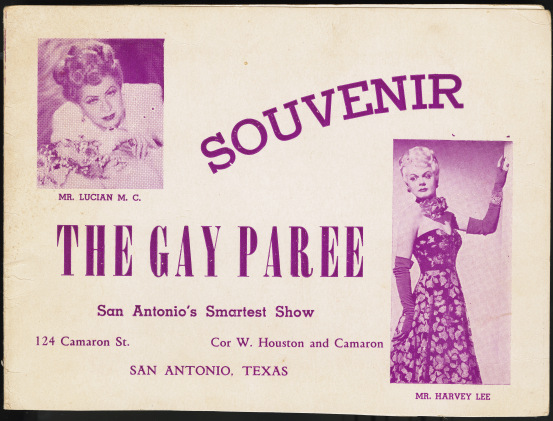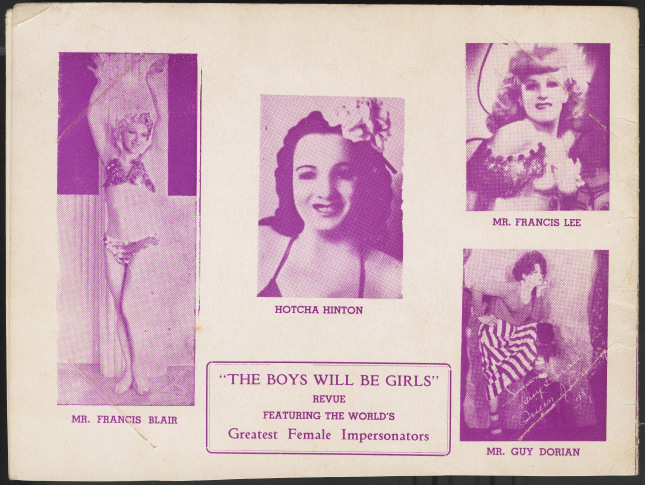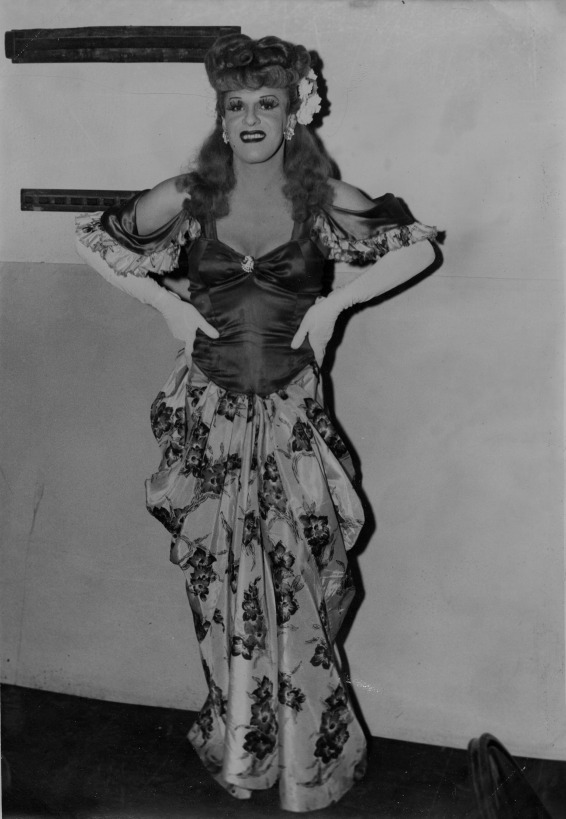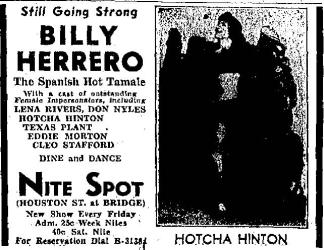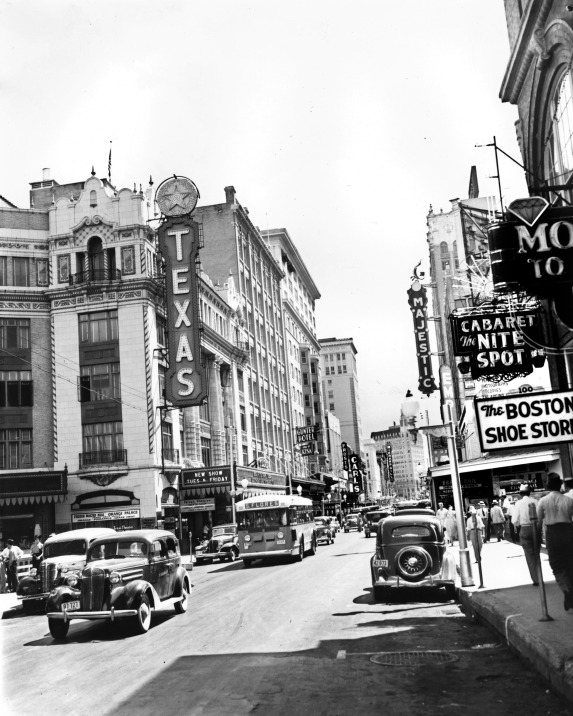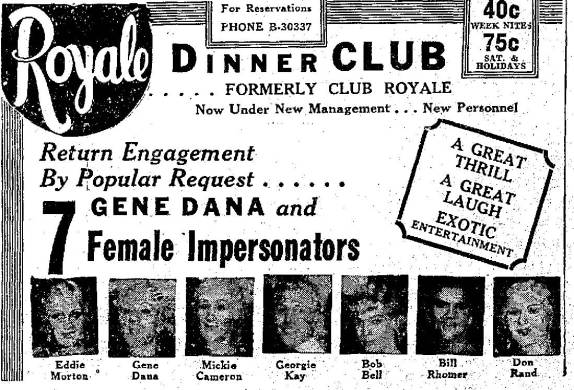Melissa Gohlke: San Antonio’s Drag Culture of the 1930s and 40s
A Bit of Texas LGBTQ History
by Melissa Gohlke[1]
Republished by permission from UTSA Libraries Topshelf-San Antonio's Drag Culture of the 1930s and 40s
“MY, OH MY! WHAT A SHOW!” A 1949 advertisement for the Gay Paree touted the “Boys will be Girls” revue which enjoyed a long run at the nightclub. Female impersonators drew in the crowds providing patrons a glimpse into the exotic world of gender-bending gay performance. Where was this nightclub you might ask—San Francisco or New York? New Orleans, perhaps? Cabarets featuring female impersonators were staples in these cosmopolitan centers. But in San Antonio—cradle of Texas liberty, home of the Alamo, queer culture would have been on the fringes of society, right?
Not so. Gay Paree was one of several nightclubs located in the heart of the River City that drew famous female impersonators from around the country. Harvey Lee, pictured in this souvenir program, was a nationally known performer. According to one recollection, “Harvey Lee, originally from Little Rock, Arkansas, was known for his elegant entrances, always dressed beautifully, and accompanied by his two large, white Afghan hounds.”[2] Lee shared the stage with Francis Blair, “a polished and lovely Prima Donna” and star in Seattle’s Garden of Allah cabaret.[3]
Gay Paree souvenir program [exterior], General Photograph Collection, MS 362, University of Texas at San Antonio Libraries Special Collections from the Institute of Texan Cultures
Gay Paree souvenir program [interior], General Photograph Collection, MS 362, University of Texas at San Antonio Libraries Special Collections from the Institute of Texan Cultures
Francis Lee aka Minnie Meyers photograph, 1949 Gay Paree souvenir program [insert], General Photograph Collection, MS 362, University of Texas at San Antonio Libraries Special Collections from the Institute of Texan Cultures
In 1949, Hotcha Hinton headed the lineup of “The Boys Will Be Girls” revue, creation of Texas female impersonator, Ray Bourbon.[4] Hotcha wooed audiences with her outrageous costumes and comedic burlesque. Don Paulson, in An Evening at the Garden of Allah: A Gay Cabaret in Seattle, writes that: “she charmed and fooled both her audiences and her interviewers into seeing her as a woman. Her desire to be accepted as a woman was so strong that she simply failed to tell people she was man.”[5]
Hotcha was a guest performer at San Antonio cabarets beginning in the late 1930s. In 1937, she was billed as the "dynamo of dance," at the Nite Spot on East Houston Street. She starred alongside Billie Herrero, known as the "Spanish Hot Tamale," who presented his male revue on the stages of local clubs. The San Antonio Light exclaimed: "Herrero and his boys have proven so popular with the patrons that the management have extended their engagement through the summer. A clever and lavish revue is presented each Friday night."[6]
Houston Street in downtown San Antonio, 1939. The Nite Spot is on the right, located in the heart of the city's entertainment district. Zintgraff Photograph Collection, MS 355,University of Texas at San Antonio Libraries Special Collections from the Institute of Texan Cultures
While female impersonators drew crowds to cabarets during the 1930s, not all of San Antonio's citizens appreciated the "exotic entertainment" presented at downtown venues. In May 1935, deputy sheriffs jailed seven female impersonators after receiving complaints about a show at the Club Royale on Broadway. The performers were released "after spending several hours in jail, during which they presented a program for other guests."District attorneys, unable to find grounds on which to detain and charge the performers, released "Georgie Kay and His College Boys" who agreed to leave the city.[7]
The entertainers, however, did not leave San Antonio as promised and in July they were held on morals violations and charges of indecent exposure. Georgie Kay and His College Boys proved to be as popular in the courtroom as they were on stage. "Many spectators who had gathered in the courtoom were disappointed when the cases were continued. Court attaches said they had had numerous telephone inquiries about the date of the trials."[8]
The fascination with female impersonators during the 1930s occurred as the "pansy craze" swept across America.[9] Coming on the heels of the Harlem Renaissance, attraction to the alluring world of homosexuals was not confined to New York and San Francisco. Bohemian attitudes and attractions made their way into locales across the country and San Antonio was no exception. While the craze lasted into the early 1940s for most cities, San Antonio's captivation with drag performance and culture survived well beyond World War II.
Future posts will focus on other facets of this untold chapter in San Antonio's history such as how the city's heterosexuals used drag performances like the Womanless Wedding to attract audiences to events. Willingness to cross gender boundaries and push social norms facilitated the growth of spaces where acceptance of diversity made possible the emergence of a queer community.
Notes
- ↑ The author is currently working on a book about San Antonio's LGBTQ history based on her Master's thesis: "Out in the Alamo City: Revealing San Antonio's Gay and Lesbian Past, World War II to the 1990s." She's uncovered some remarkable stories and wants to share these discoveries with our LGBTQ community.
- ↑ Norm Billings, letter included with The Gay Paree souvenir program, August 13, 1997, General Photograph Collection, MS 362, University of Texas at San Antonio Libraries Special Collections from the Institute of Texan Cultures.
- ↑ Don Paulson with Roger Simpson, An Evening at the Garden of Allah: A Gay Cabaret in Seattle (New York: Columbia University Press, 1996), 135-140.
- ↑ Nite spot advertisements, San Antonio Light February 18, 1949, 14A; August 14, 1937, 5A; http://www.squidoo.com/Pansy.
- ↑ Paulson, Garden of Allah, 141-146.
- ↑ “Spanish Tamale Draws At Nite Spot,” San Antonio Light, August 1, 1937, 14A.
- ↑ “Female Impersonators Agree to Leave City,” San Antonio Express, May 28, 1935, 18.
- ↑ Royal Dinner Club advertisement, San Antonio Express, June 22, 1935, 10; “Female Impersonators Held In Morals Case,” San Antonio Express, July 5, 1935, 18; “Female Impersonators’ Trials Are Postponed,” San Antonio Express, July 6, 1935, 16. The outcome of the trials is unknown.
- ↑ Chad Heap, Slumming: Sexual and Racial Encounters in American Nightlife, 1885-1940 (Chicago: University of Chicago Press, 231-276.
